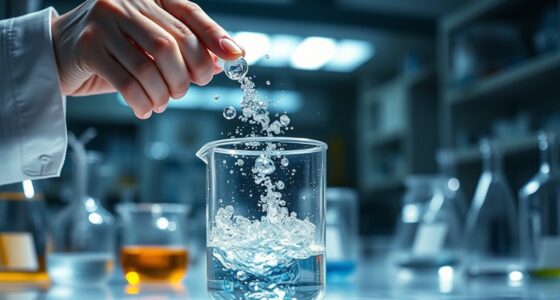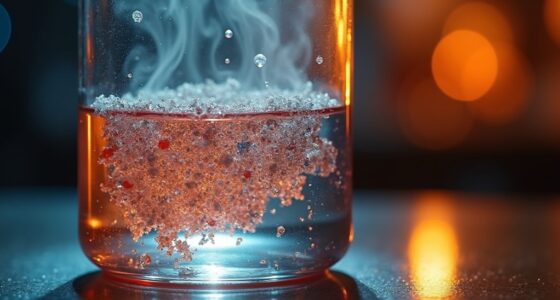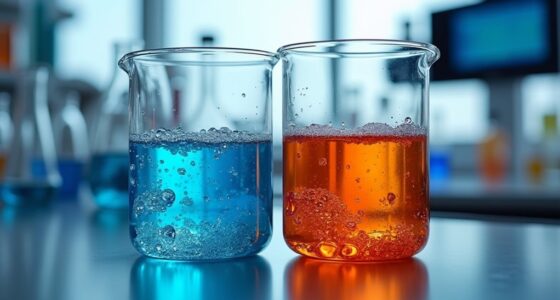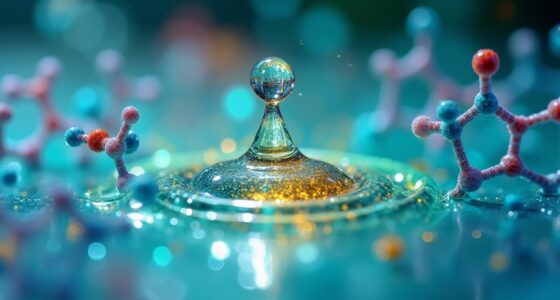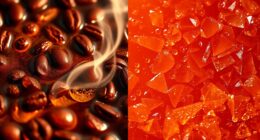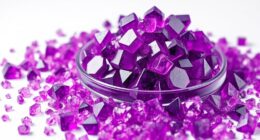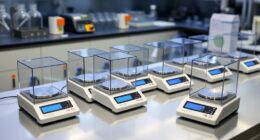Mixtures and compounds differ mainly in how their substances are combined. Mixtures are made by physically blending different materials, so their components keep their original properties and can be separated easily. Compounds form through chemical reactions, creating new substances with fixed ratios and unique properties that require chemical processes to break apart. Understanding these differences helps you see how substances behave and interact, with more details awaiting to expand your knowledge.
Key Takeaways
- Mixtures are physical combinations of substances, while compounds are chemically bonded substances with fixed ratios.
- Mixtures can be separated by physical methods; compounds require chemical reactions for separation.
- Components in mixtures retain their original properties; compounds have new, consistent properties due to chemical bonds.
- Mixtures have variable composition; compounds have a definite, fixed chemical formula.
- Mixtures are formed by physical processes; compounds are formed through chemical reactions involving molecular reorganization.
Understanding the Basic Definitions of Mixtures and Compounds
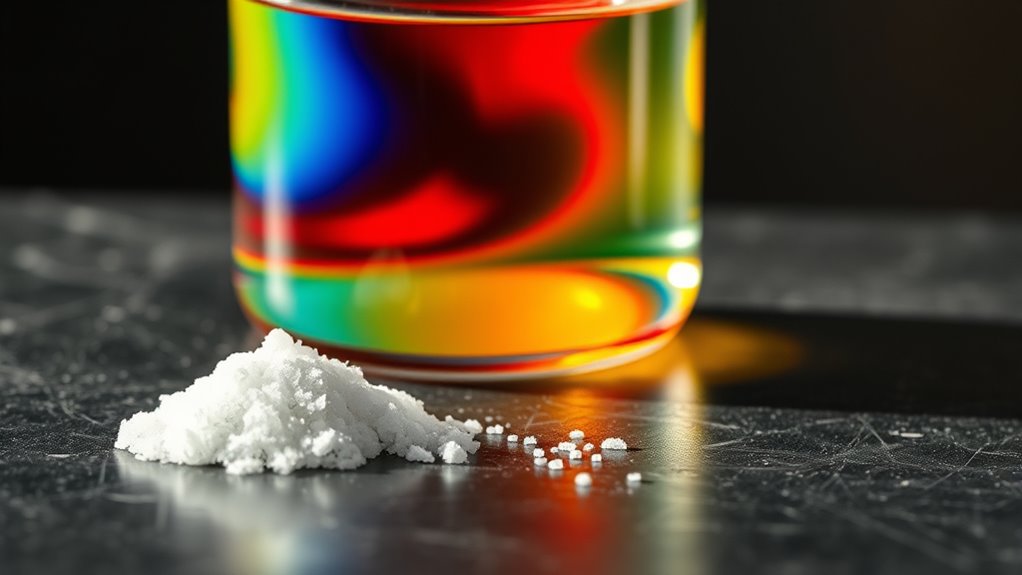
To understand the basic difference between mixtures and compounds, it’s important to know how they are formed and what they consist of. Mixtures are created through physical combinations of two or more substances, with no chemical bonds involved. Their components keep their original properties and can be separated easily using physical methods like filtration or distillation. Compounds, on the other hand, result from chemical bonds forming between elements in fixed ratios, creating new substances with different properties. Their molecular structures are uniform throughout, making them homogeneous. When you separate a compound, it breaks down into elemental forms through chemical processes. Unlike mixtures, compounds involve molecular reorganization, and their composition is fixed, not variable. This fundamental difference shapes how each behaves and can be manipulated. Additionally, understanding the process of chemical bonding is crucial to comprehending how compounds are formed and how they differ from mixtures.
How Mixtures and Compounds Are Formed
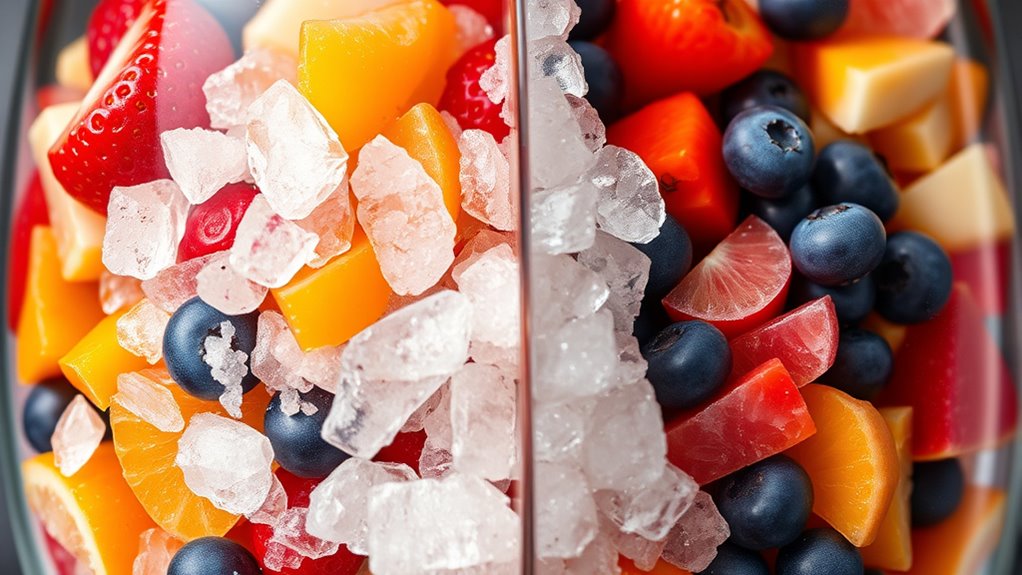
Mixtures and compounds form through fundamentally different processes, which determine their properties and how they can be separated or combined. Mixtures are created through physical processes like mixing or mechanical blending, where substances are combined without chemical bonding. No new substances are formed, and the components retain their original properties. The proportions in mixtures can vary, and they are easily separated by physical methods such as filtration or distillation. In contrast, compounds form through chemical reactions involving chemical bonding. Elements combine in fixed proportions, resulting in a new substance with different properties. These strong bonds make compounds more stable and non-separable by simple physical means. The formation of compounds often requires specific conditions like heat, pressure, or catalysts to facilitate chemical bonding. Understanding these processes enhances our grasp of chemical principles, molecular interactions, and their applications. Additionally, the structure of compounds is often more complex due to the specific arrangements of atoms involved, which influences their properties and behavior. Recognizing the bonding mechanisms involved helps explain why compounds are typically more stable than mixtures.
The Composition and Structure of Mixtures Versus Compounds
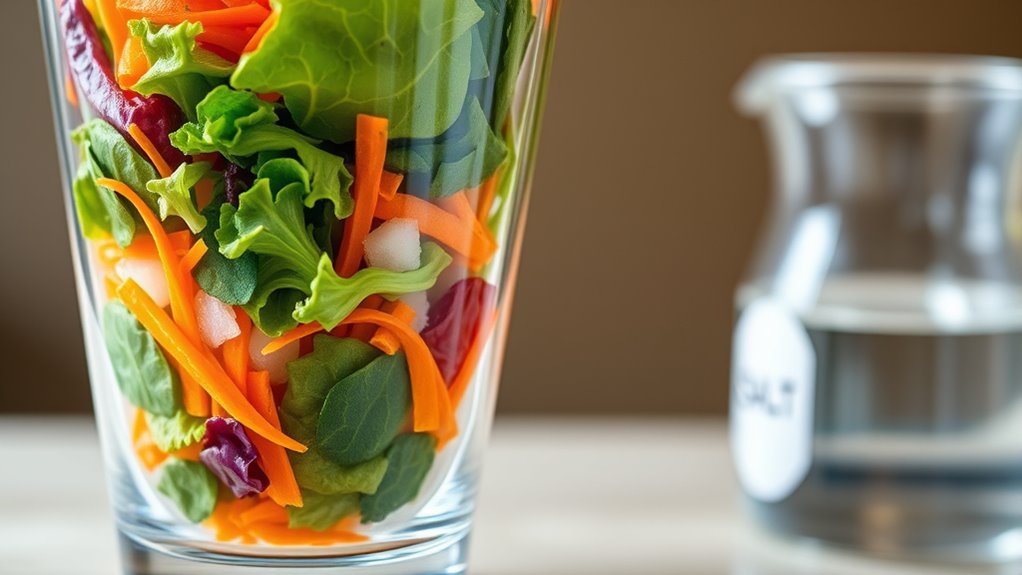
Understanding the differences in composition and structure between mixtures and compounds is essential because they behave very differently. Mixtures are physically combined, so their composition varies, and the individual components retain their chemical identities. They can be homogeneous or heterogeneous, with no fixed molecular arrangement. Molecules in mixtures do not form specific bonds, so molecular interactions are minimal. Conversely, compounds are chemically bonded through specific bond types, like ionic or covalent bonds, creating a fixed, uniform molecular structure. This structure results in constant properties and distinct chemical behavior. In compounds, elements are bonded in a repeating, organized pattern, making separation impossible without chemical reactions. Recognizing these structural differences helps clarify how each substance behaves and interacts in different contexts. The molecular arrangement of compounds is highly organized, which is why they have specific chemical formulas and properties.
Methods for Separating Mixtures and Compounds
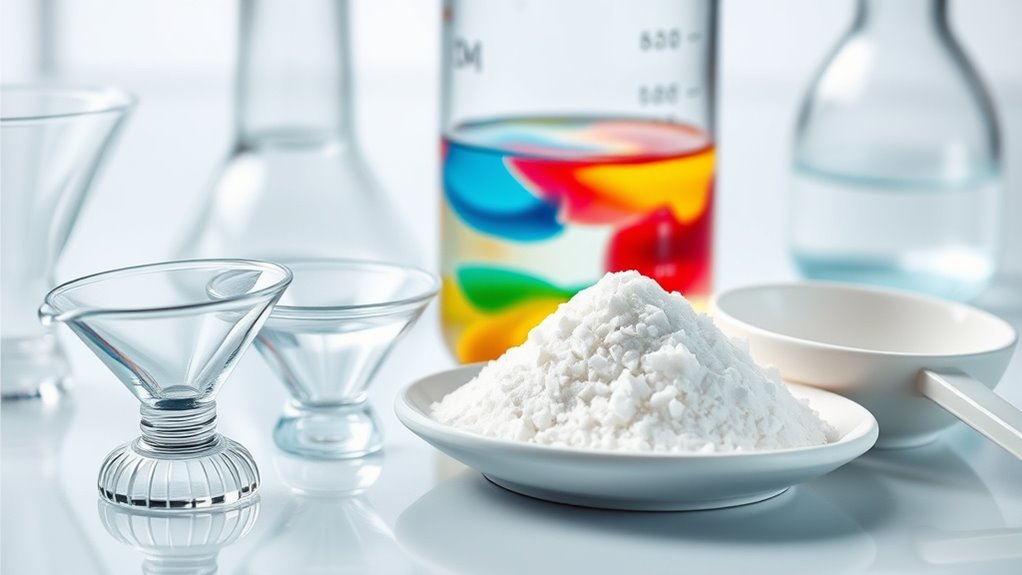
Methods for separating mixtures and compounds vary depending on their physical and chemical properties. You can use chromatography techniques like thin-layer chromatography, column chromatography, or gas chromatography to separate components based on their affinity for stationary and mobile phases. Physical separation methods such as filtration, evaporation, and sieving rely on differences in size, state, or density. For example, filtration removes solid particles from liquids, while evaporation separates volatile substances by heating. Centrifugation and separating funnels leverage density differences to isolate components. These methods work well with mixtures, but compounds usually require chemical processes like dissolving or recrystallization. Separation techniques are essential in various industries, including pharmaceuticals and environmental science. Understanding these techniques helps you choose the right approach to efficiently separate and analyze different substances. Additionally, recognizing the properties of compounds is important for selecting appropriate separation methods, as chemical methods often depend on the specific reactivity or solubility of the substances involved. Moreover, physical and chemical properties influence how effectively a separation method can be applied to a given mixture or compound. It is also crucial to consider the reactivity of compounds, as certain chemical separation methods depend on specific reactions to separate substances effectively. Being aware of the purity and composition of the substances can further guide the selection of the most suitable separation method. For example, knowledge of dispersibility can be useful when choosing between different physical separation techniques.
Properties and Behavior of Mixtures Compared to Compounds
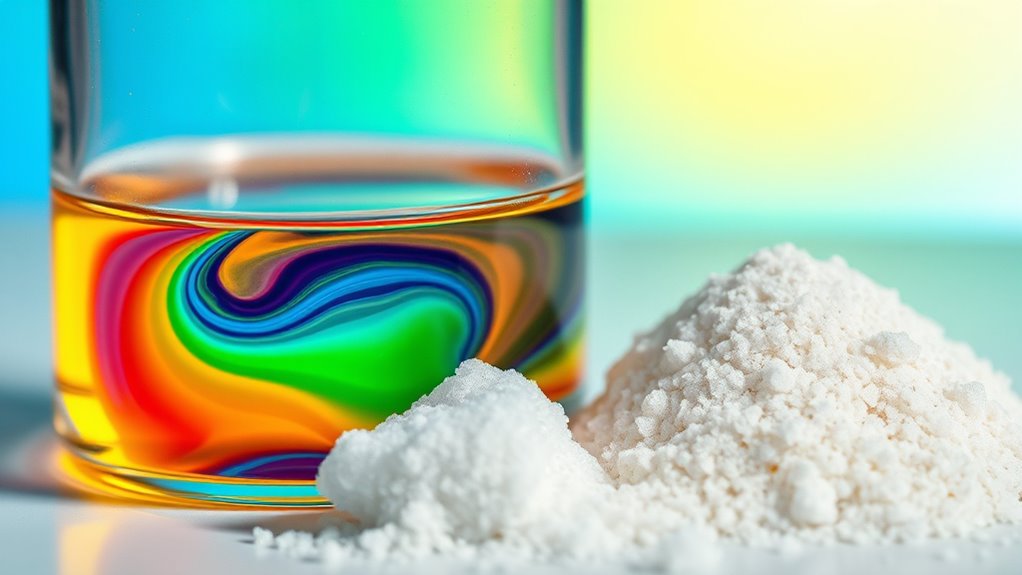
When separating substances, recognizing their fundamental differences helps you choose the right method. Mixtures and compounds display distinct properties and behaviors because of their different chemical bonding and formation processes. Mixtures are physically combined, so their property variation is flexible; they can have varying compositions and textures, and their components retain their original characteristics. They react physically, not chemically, and can be separated easily through methods like filtration or evaporation. In contrast, compounds involve chemical bonding, creating new substances with unique properties different from their elements. Their formation requires chemical reactions, often involving energy input, and they tend to be more stable. Their properties are consistent and uniform, making them identifiable by their chemical formulas. This fundamental difference influences how both mixtures and compounds behave and react. Additionally, understanding water’s properties can help clarify how it interacts with various substances in both mixtures and compounds. Recognizing chemical bonds is essential for understanding why compounds have fixed compositions and properties. The stability of compounds also makes them important in chemical reactions, which are fundamental to many processes in science and industry.
Examples of Common Mixtures and Compounds in Daily Life
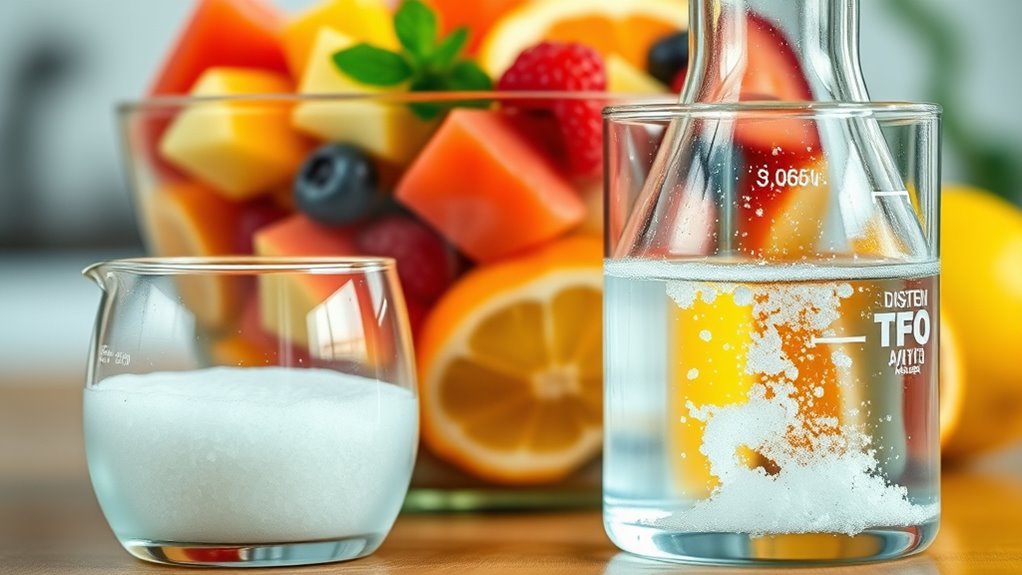
Have you ever wondered how the objects around you are made up of simple mixtures or pure compounds? Many everyday items are mixtures, like smoothies, perfumes, or cleaning solutions, where different ingredients are combined without chemical bonding. For example, food pairing often involves mixing flavors in sauces or salads, showcasing mixtures’ versatility. On the other hand, compounds like table salt (sodium chloride) or water are chemically bonded substances with specific properties. Recognizing these differences helps you understand chemical reactions better—mixtures can be separated easily, while compounds require chemical processes to break down. This knowledge enhances your appreciation of how common household items, foods, and even cosmetics rely on mixtures or compounds for their unique functions. Mixtures are composed of two or more forms of matter that are separated by physical methods.
Practical Applications and Significance in Industry

Practical applications of mixtures and compounds play a crucial role in industries by enabling efficient separation, synthesis, and material enhancement processes. Industrial separation techniques like distillation, electrolysis, centrifugation, chromatography, and crystallization allow companies to isolate and purify raw materials and products, such as extracting fuels or pharmaceuticals. Chemical synthesis methods, including producing sulfuric acid, ammonia, and polymers, facilitate the creation of essential chemicals and materials used daily. These processes improve product quality, reduce costs, and increase efficiency. For example, catalytic converters and corrosion-resistant stainless steel enhance automotive and construction durability. Additionally, filter materials like activated carbon are vital in environmental applications to minimize pollution. In environmental applications, activated carbon filters and CO₂ scrubbing minimize pollution. Understanding chemical reactions and their applications helps industries optimize production, ensure safety, and develop innovative materials crucial for modern society. Moreover, industrial processes often rely on precise control of conditions to maximize yield and purity, which is essential for maintaining high standards in manufacturing.
Frequently Asked Questions
How Can I Tell if a Substance Is a Mixture or a Compound?
To classify a substance, you need to observe its physical and chemical properties for proper chemical identification. If it’s uniform and has a fixed composition, it’s likely a compound, formed through chemical bonds. If it shows visible separate parts, variable composition, or can be separated physically, it’s a mixture. Use methods like filtration or looking at melting points to help determine whether it’s a mixture or a compound.
Can Mixtures Become Compounds Through Physical Processes?
You might wonder if mixtures can turn into compounds through physical separation, but the answer is no. Physical separation processes like filtration or distillation only divide mixtures into their original components without changing their molecular structures. To form compounds, you need a chemical transformation—breaking and forming bonds—something physical separation can’t do. So, mixtures can’t become compounds just by physical methods; that requires a chemical reaction.
Are All Homogeneous Mixtures Considered Solutions?
Not all homogeneous mixtures are considered solutions because some can be separated through physical techniques like filtration or evaporation, which rely on differences in physical properties. Solutions are a specific type of homogeneous mixture where the solute is completely dissolved in the solvent, forming a single phase. If a mixture’s components can be separated easily without changing chemical bonds, it’s likely a homogeneous mixture but not necessarily a solution.
What Are the Health Impacts of Consuming Mixtures Versus Compounds?
The health risks of consuming mixtures can be overwhelming, with unpredictable effects that may skyrocket your chances of illness. Unlike compounds with predictable, well-understood impacts, mixtures pose complex challenges, making nutritional differences harder to assess. You might unknowingly face synergistic interactions that amplify toxicity or health problems. This complexity increases your vulnerability, demanding careful study and regulation, which are far less straightforward than with individual compounds.
How Do Mixtures and Compounds Affect Environmental Pollution?
You see, pollution sources often release both mixtures and compounds, impacting the environment differently. Mixtures, like smog, cause complex, unpredictable effects and challenge remediation strategies due to their variable composition and synergistic toxicity. Compounds, such as pesticides, form stable molecules with predictable behaviors, making cleanup more straightforward. Understanding these differences helps you develop effective pollution mitigation and remediation strategies tailored to each type, reducing ecological damage and safeguarding public health.
Conclusion
Understanding the difference between mixtures and compounds helps you see how substances interact daily. Did you know that over 70% of the Earth’s crust is made up of mixtures like air and soil? Recognizing these differences allows you to better grasp the world around you, from cooking recipes to industrial processes. So, next time you see a mixture or a compound, you’ll know exactly what makes them unique and why they matter in everyday life.


